Mary Fleming's Blog, page 9
September 26, 2020
History Lessons
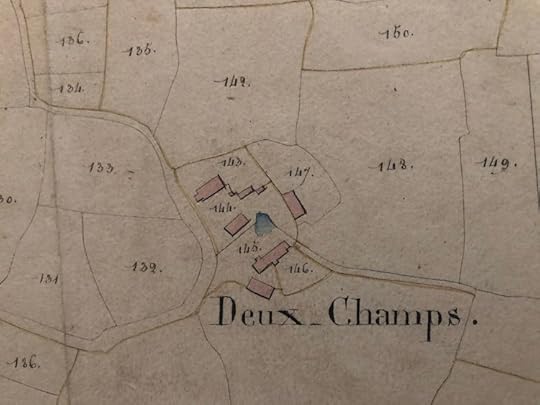
Friday, 25 September
As I was saying last week, before a fire interrupted me:
Sometimes I look at the barn we are turning into living space out here in the Perche and am surprised it’s still standing. The masons, back from their summer holiday, have continued to blast holes in the walls for more windows and doors. Meanwhile the terrassier has got to work and added his own holes while digging trenches for plumbing and electricity. It can be hard to see the creative side to our current destruction.

Meanwhile this last month we've been learning a lot about the long history of this property. Local historian Eric Y, whom we commissioned to document it, came by in August to show us the original deeds and to whet our appetite with some of what he had already learned. The day before the fire he delivered his final three-volume report.
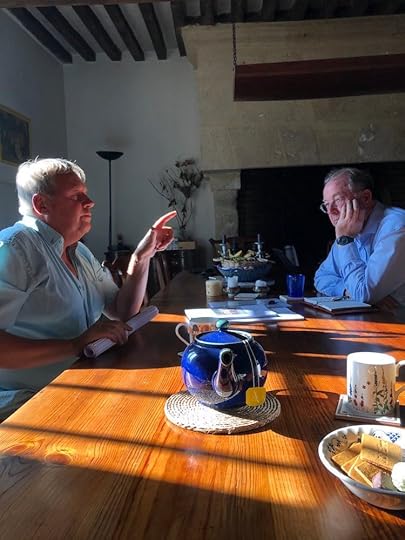
His thorough account provides a general history of the property, a detailed register of all the owners, as well as their genealogies. There are photocopies of some of the old deeds and transcribed extracts of others, as well as of leasing contracts. There are photos of notable architectural features.
 Sun dial next to the front door
Sun dial next to the front doorIn the earliest existing written records from the 15th century, Deux Champs, surrounded by fields as its name indicates, consisted of the ruins of a château on the spot where our barn-in-transition now stands, plus four farmhouses with various outbuildings, a garden, an orchard and a vineyard.
 Descendent vine
Descendent vine The first surviving property transaction is dated 21 December 1469. Jean Louët, lord and overlord of Deux Champs, signed an agreement to rent some of his land to Jean Culaiou, whose descendent Yves Culaiou would build the house in 1587 that we would buy almost 450 years later.
 David, where Yves once stood
David, where Yves once stoodUntil the French Revolution Deux Champs was governed by a suzerain direct (direct lord), who was in turn beholden to a seigneur suzerain (overlord). Interestingly, these lords could be ladies. Charlotte Angélique de Cochefilet, lady of Vauvineux, of les Chaises, of Montraversier and of Deux Champs, wife of Charles de Rohan, prince of Guéménée, 5th duke of Montbazon and peer of France, for example, inherited the title in 1661.
Things took a pedestrian turn after the Revolution, when Deux Champs became just a farm, owned and run by commoners with shorter names and no titles.
The property documents throughout the centuries choreograph a complicated dance of parcels of land being bought, sold or leased, of the property changing hands entirely. The Paigné, Culaiou, Brisard and Poitevin families were pre-Revolution proprietors and the Bourgeteau, Aubert and Lesueur post. Fortunes rose and fell as people married and had children. Or didn’t. Issaye Matthieu Poitevin, a wealthy 18th century curate, passed on Deux Champs to his curate nephew Jean Matthieu, who "must have died" during the Revolution (we can imagine not of natural causes).
It does seem that offspring who are only children (except for poor Jean Matthieu) generally consolidated or expanded land ownership, at least partly because they didn’t have to share the goods with multiple siblings. In the mid-17th century Reneé Culaiou, for example, only child of Yves, inherited this house that her father built but no land. She and her husband Pierre de Brisard set about buying up lots in an attempt to reassemble the estate as it had been before being split in three by Raoul Louët's 1525 succession. Much later, in the late 19th century Jean Aubert and his only son Jean Félix, had equally acquisitive instincts. It was an affluent Jean Félix who built the barn we are now renovating.
Not all only children, however, assumed the land-owning mantle willingly. In 1931 Camille Lesueur, according to recent testimony from his daughter Colette, was forced by his parents to take over the farm even though he wanted to be a mechanic. It was only after the death of his mother in 1962 that he was able to sell most of the property and set up a garage in the nearby village.
 The Lesueur family, Colette front and centre; her brother André at her side (Oct '19)
The Lesueur family, Colette front and centre; her brother André at her side (Oct '19)Monsieur Lesueur sold to Monsieur B, after whom the house and land were once again separated.
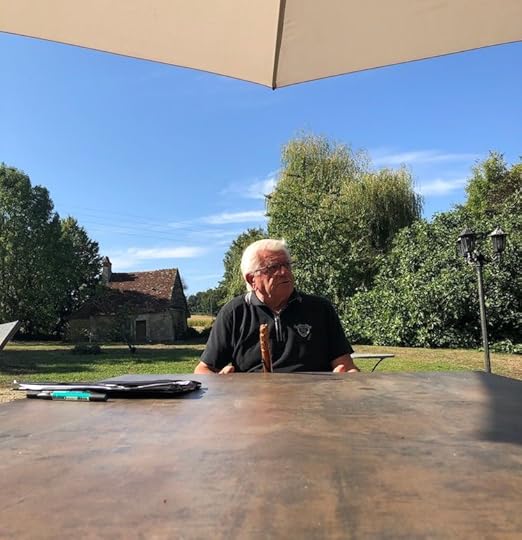
The house went to the Poussiers, then Corinne and Frédéric, then us. The land was bought by Monsieur L, who sold it to us. For the moment he still farms the fields; it was his corn that almost went up in flames last week.
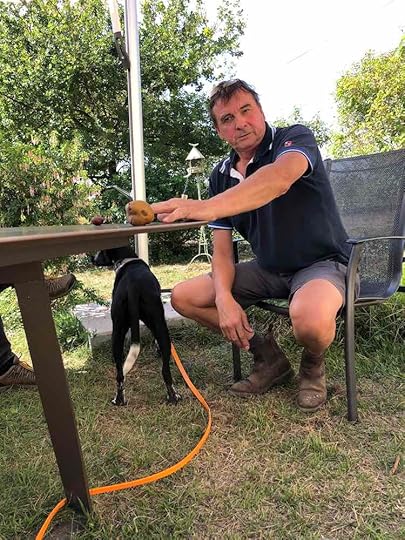
Though getting all this straight was not easy it was worth the effort. Property documents can highlight some interesting historical quirks. Several early owners converted to Protestantism, until the Edict of Nantes promoting religious tolerance was revoked by Louis XIV in in 1685. Contracts in the years following the Revolution used the French Republican Calendar and are dated 22 vêntose year III or 26 messidor year X.
Property arrangements can also be a window onto how people lived. Until well into the 19th century leaseholds always included more than mere monetary remuneration. In 1716, Mattheiu Poitevin, a lawyer and father of the curate Issaye, rented out the farm and retained the right to use the house whenever he wanted (it does not stipulate where the Peigné family was to sleep during these visits). The renters also had to provide him with “20 pounds of fresh butter every September, 2 capons for Christmas and one day’s use of the horse cart harness." Furthermore, they had to take proper care of a pear tree located “in the hedge, at the top of the orchard. The fruit must be picked and delivered to the landlord, at his home.” Curate Jacques, the one who didn’t survive the Revolution, expected 1 fattened goose, 4 capons for Christmas and 4 chickens for the feast of St John the Baptist from his lessors. Had he lowered his demands he might have fared better.
As owners have changed, so have the buildings. If you look at the 1823 land survey map at the top, only two of the structures exist today, our house and the bakery, which used to be twice as long and home to the resident bull.

Monsieur B told us he filled in the pond in front of boulangerie that you see on the map but not in the above photo. Monsieur L told us it was he, at the request of the Monsieur B's ex-wife, who tore down the barn built in 1578. The next owners eliminated a stone spiral staircase in the main house that went from the cellar to the attic.
While these relatively recent losses cause a pang of regret, it's important to focus on what is quite amazingly still here and little changed after all these centuries. It's easy for me to imagine Renée Culaiou or Anne Boussart, also wife of a lawyer (Matthieu Poitevin), walking out the same front door in the morning to walk their dog. I can see Marie Jeanne Aubert poking logs in the same fireplace.
When you buy an old house, you're very much a successor to all those who have come before you and a caretaker for those who will come after. Though our renovation project is taking the house firmly away from its agricultural roots, we have bought back at least half of the property's former 41 hectares (101 acres) and are developing plans to re-green it in a 21st century way. With luck by the time we are just two more names on the list of Deux Champs proprietors, we'll have done our bit and left a positive mark.
 La Princesse, new seigneure of Deux Champs
La Princesse, new seigneure of Deux Champs
September 19, 2020
Not the Way I'd Planned It
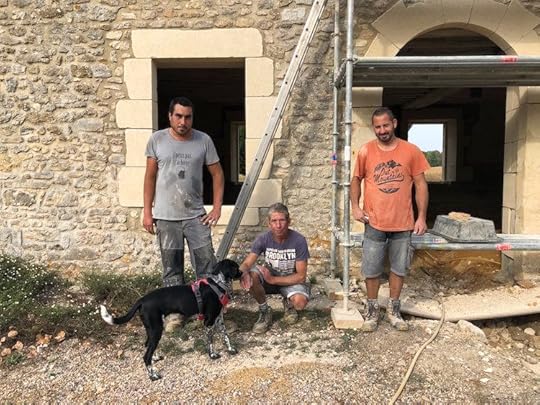
Friday, 18 September
Today began like most second Fridays. I woke up and worked on my blog, walked the dog, ate breakfast and worked more on my blog, this one about progress on our barn reconstruction project, as well our growing knowledge of this place in the Perche that we bought last year. Recently we have had visits from several people who know it well, including the last owner of both house and land. Yesterday the local historian Eric Y returned with his completed three-volume report on this 600-year old property.

As I sliced some tomato and avocado for lunch, the names of past owners, the configurations and reconfigurations of the property and some of the report’s more colourful details were still swirling in my head. I opened the fridge to get out some cheese and the light was off. So were the little green lifeline lights on the internet box in the corner. I trotted across the courtyard to the main electricity switch and it was still on. As were all the fuse boxes. Strange, I thought, as I dribbled oil and lemon on my salad. Maybe they’re working on the line. The masons had gone on their lunch break; David was walking Tasha.
Just as I sat down the front door burst open. “The field is on fire,” said David.
Indeed a large patch of field, right next to the desiccated maize, was burning. Low flames were licking up at the edge of the hedge that rings our garden. At first I couldn’t imagine how the fire had started. Certainly not, as with the El Dorado blaze in California, from 'a pyrotechnic device' set off at a gender-reveal party. Spontaneous combustion from extreme drought? Then I noticed that the electric wires, which usually stretch high above us from one concrete pole to another, were severed and on the ground. The wind had been blowing quite strongly and a tree in the overgrown hedgerow must have snapped it.
I called the fire department. The man asked me a million questions but finally promised to send an engine. The minutes lasted forever. Because of the broken electric wire, we were afraid to carry water over to the field ourselves. Each time a gust of arid wind blew, my heart leapt like one of those flames. With photos of the apocalyptic fires on the west coast of the US much on my mind, I imagined the hedgerow whooshing up, thus causing the old elm, a rare survivor of the Dutch elm disease that ravaged its family 50 years ago, to catch fire. The weeping willow would be next, then the massive fig tree that started life nestled next to a barn built in 1587 that, we recently learned, had been torn down 30 years ago. Then embers would fly over to the 450-year old house and it too would go up in flames, a moment of perfect irony, given that we had just commissioned its history.
Fortunately the masons returned from lunch. Christophe, le chef, mobilised his two colleagues to wet old sweaters and beat down the areas approaching the corn and the hedgerow. While David drove out to meet the firemen and ensure that they didn't get lost (GPS doesn't always get you here), I soaked some old sheets and supplied The Team.

By the time the pompiers drove up, the worst of the fire was over but it was still a relief to have professionals and some hoses on the scene.

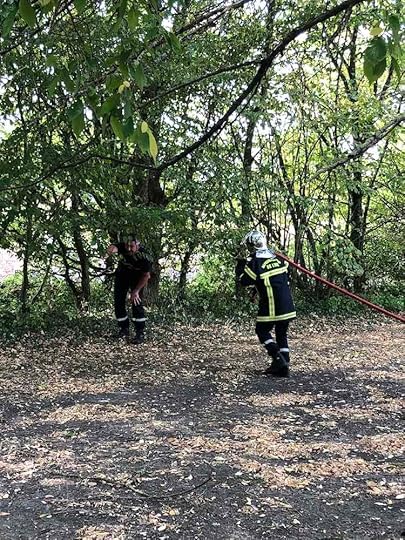

The fire chief looked over at the maize and said: “I guess no popcorn today.”
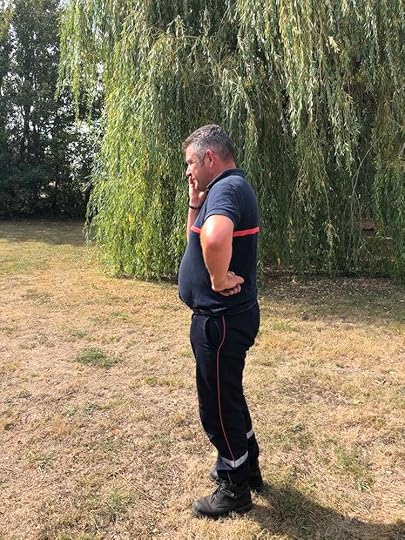
Two men from the electric company Enedis arrived. I asked one when we might get the power back. “In a week,” he said.

“Okay,” I replied gamely. My sister in Connecticut, after the last hurricane, had no electricity for six days.
He looked at me, astonished. “I’m just kidding. It’ll be back on by this evening.” And indeed it was.
That we got off so lightly seems a miracle. Conditions, which I have written about frequently and was determined not to mention today, despite being on my mind night and day, were perfect: drought, wind and heat (after a scorching August, we have been hovering around 30°C/86°F this mid-September). Every morning, walking with Tasha, I hear the brittle corn crackle flammably.
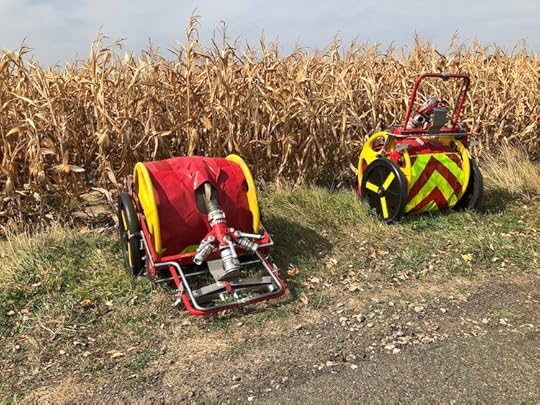
I feel both incredibly lucky and grateful. Christophe’s quick thinking helped avoid disaster. Public sector France did its public sector job. The firemen arrived as promised and the electricity repairmen spared us great inconvenience.
Late afternoon I tried to give Christophe some money to replace the clothes ruined in beating out the fire but he refused, saying: "We just did what anyone would have done." All he would let me do was take the top photo. Though Tasha didn't deserve to be in it (she had barked at the firemen and eaten my avocado after being locked in the house), he insisted.
The fire gave us a good scare, even if it was in the end rather a non-event, especially in the context of the raging conflagrations elsewhere, but also in the long history of this place, about which I will finish reporting next week. The nano-episode did, however, restore some faith in humanity, made me happy all over again to be living down here at the end of the lane in the Perche.
 Saturday morning; order restored
Saturday morning; order restored
September 5, 2020
A Precarious Position

Friday, 4 September
As a child I dreaded going back to school in September. During the summer my mind had softened like overripe fruit and firming it back into academic shape loomed as a daunting prospect. The condition lightened a bit in early adulthood, then got worse again when I had my own children and re-lived that churning back-to-school stomach through them.
The kids have long grown up and most summers now I keep working. August is no more than a comma, a partial pause, in the flow and I usually look forward to the more rigorous schedule that comes with the cool weather.
But the year 2020 seems determined to be strange, off-kilter, in every way. August was too hot, too dry, too windy and I went to the vet seven times; September has me jittery once again.
The first days of August the heat was so brutal that the masons transforming our barn into living quarters arrived for work at 6am and stopped at 2pm. At the end of the week they tidied up their chantier and left on holiday…
 Territory reclaimed by swallows
Territory reclaimed by swallows…leaving us and the swallows in blissful but canicular peace.
No sooner had the workers gone, however, than Tasha returned from a jaunt bleeding profusely. It was only a small tear in her ear, probably caused by a bramble or bit of barbed wire, but the blood was everywhere, including all over us.
The vet bandaged her up like Vincent.
 Tasha Van Gogh
Tasha Van GoghAs you can see, she was miserable, though she really surprised us. Usually a dog who shares her every emotion, Tasha suffered her fate in stoic silence.
Next vet visit, she shook her strong head and off came the new, lighter bandage before we even got through the exit. Blood sprayed all over the waiting room. Third time round, ear still bleeding, the vet put in a staple and wound on another large bandage that only lasted a day.

At the 5th appointment she was deemed ready for the staple remover.
Silly us, thinking we could now relax and settle into the heat and drought. One week later she returned from another jaunt with a gash on her front leg, plus a couple minor wounds, most likely the result of an unfortunate scuffle with our resident badger.
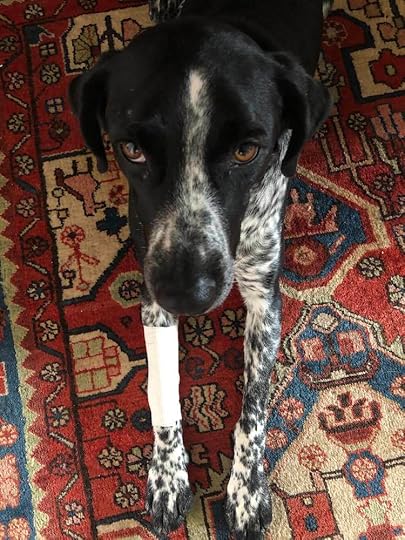
More misery and bandages and staples, which yesterday, vet visit number 7, were removed. We are hoping she does not validate the French saying jamais deux sans trois (never twice without thrice) but we are not sanguine.
Fortunately the month had more pleasant distractions. It was bracketed by family visits; the Berlin contingent at the beginning...
 Tasha and Fanny
Tasha and Fanny...and half of the Londoners at the end...
 Christopher and Kerry, who will brave a 14-day quarantine when they return to England
Christopher and Kerry, who will brave a 14-day quarantine when they return to EnglandOnce it got cool enough for movement beyond the bare minimum, we explored more of the area.
 Driveway to the Château de Lonné, Igé
Driveway to the Château de Lonné, IgéOur massive fig tree produced kilos of fruit that I turned into compote and jam…

…ditto for the plums.
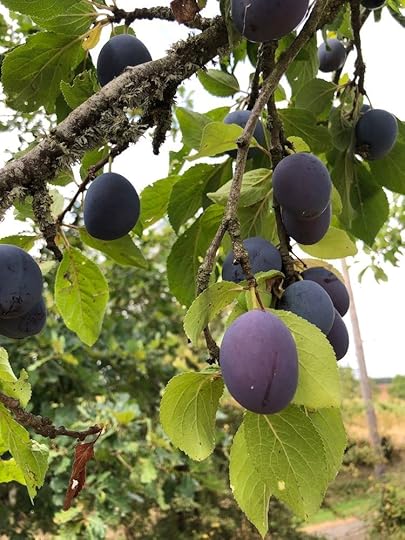
Both David and I spent less time at our desks. Given his precarious pruning from atop this ladder and other feats of near handyman disaster, I was relieved he didn’t take off any more time.
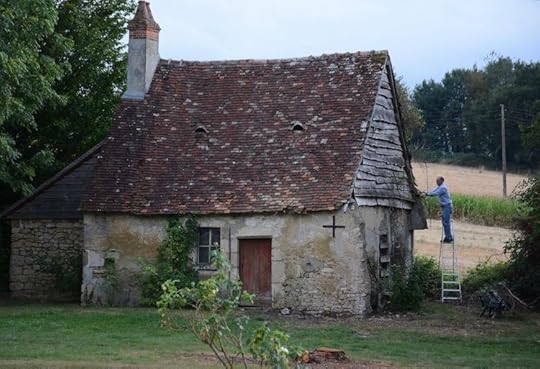
Just like last year, on the 19th the swallows had one of their rave parties and were gone the next day. It felt lonely without them. We went into Paris. It was hot and dry and windy there too.
It struck me as I was walking Tasha in the searing gusts, many of the ill chestnuts and limes already leafless..
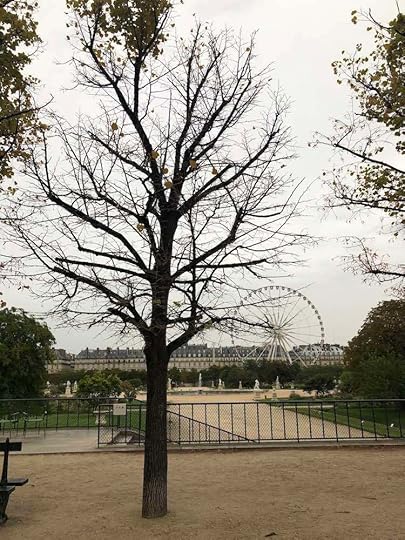
...that she is not the only one scrapping and injured this summer. The whole world right now is a battered place. By the coronavirus that continues to rage in some places and is wasting no time surging back in others (France had 8975 new cases the 4th of September, up from 7017 the 3rd).
And by rising violence, around protests in the US recently and in France around the gilets jaunes last year, but also in daily interactions with officials, or by the police themselves. I have had numerous conversations with friends about the growing incivilité between citizens in the streets of Paris. Bizarrely even horses have been under attack throughout France this summer.
Meanwhile the signs of global warming are becoming terrifyingly obvious. After three consecutive years of drought and excessive heat, trees are weakened or dead everywhere you look, out here in the Perche too. "Our Forests Are in Agony," read a recent front-page article in Le Parisien.
 Dead redwood, Château de Lonné
Dead redwood, Château de LonnéIn the old days my September dread had eased by October and I was again enjoying the pace and demands of real life. This year I wonder. Our position feels as precarious as David's on top of that ladder.
 'No Planet B', Bellême
'No Planet B', Bellême
August 1, 2020
A Human Hive
 Masonic dust
Masonic dustFriday, 31 July
Our house in the Perche this morning is more crowded than Paris. Or so it seems. We left the eerily quiet city early today in order to beat the heat (37°C/98.6°F) and the hordes of holiday makers expected on the roads at the beginning of this chassé-croisé (changeover) July-August weekend and arrived to a human hive of activity.
The farmer who cultivates our fields was mowing hay.
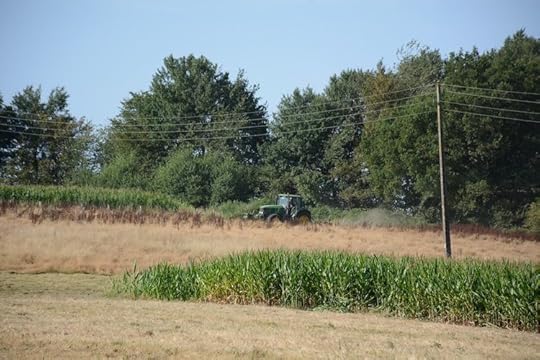
These three men were sorting the large bank of felled thuja that until two weeks ago lined the lane and cut the house off from the rest of the world with a dissuasive power worthy of the Berlin wall.

Claire, our agro-eco-garden guru, was checking on their progress. Tasha was not the only one happy to see her.
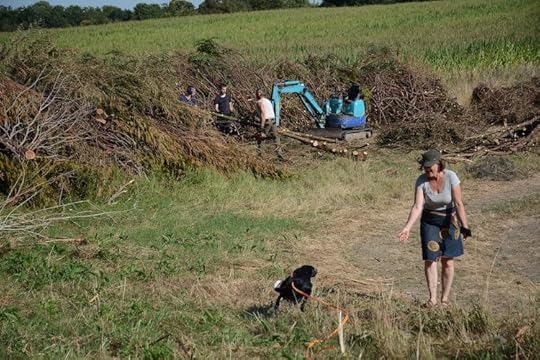
At the house the four faithful masons were arching the doors of the reappropriated barn.
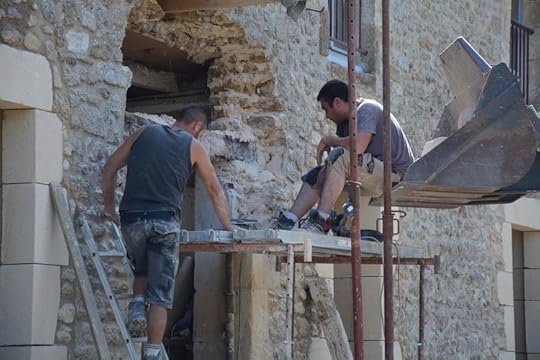
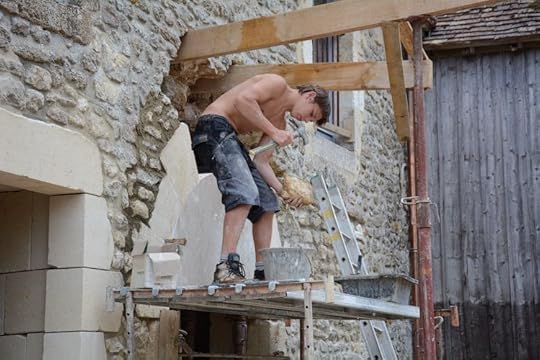

They have made a lot of progress over the last weeks and we continue to marvel at their skill in handling the heavy stone, in turning it, really, into works of art.

Though the working population is particularly dense today, our house is often busier than you'd expect of a place at the end of a road to nowhere. Last week, for example, on Claire's suggestion the local ornithologist Valentin stopped by to assess the swallow situation (more on that in a minute) and advise how we might attract higher numbers next year. In examining the possibilities, he discovered that a barn owl has moved into the hay loft that we opened up for the swallows but that has not been to their liking.
The next day the local historian Eric Y, who is working on the history of the property, came round with this pile of parchment…
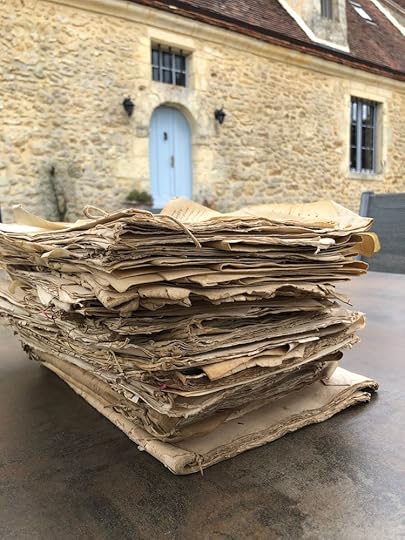
…the legal documents for the its first two hundred years. They reside in a cupboard at a nearby château and Eric, who knows the owner, had them on loan. You’ll be hearing more about this once he has finished his study but we learned quite a lot just from this one visit. The first mention of the land, for instance, dates to the 1400s and the first deed was written on 19 February 1555.
 Our predecessors
Our predecessorsThe seigneurie itself was built in 1588 as a link in a chain of similar seigneurial edifices that formed the first of two defensive rings around the town of Bellême.
Looking inside the house, he confirmed that, except for the addition of a storage annex in the 19th century (now serving as furnace/laundry room and David's office), not much of the layout has changed in 500 years. The ground floor was and still is comprised of an entry with a room on either side, each with the original walk-in fireplace ...
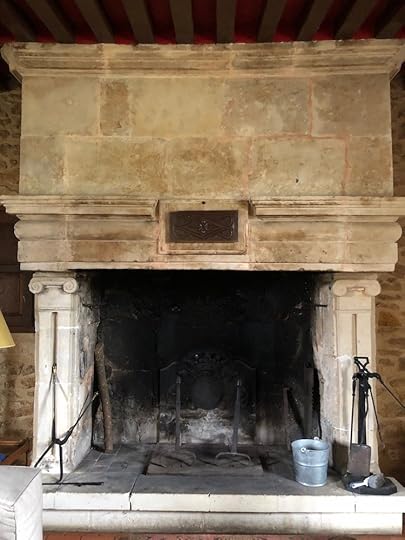
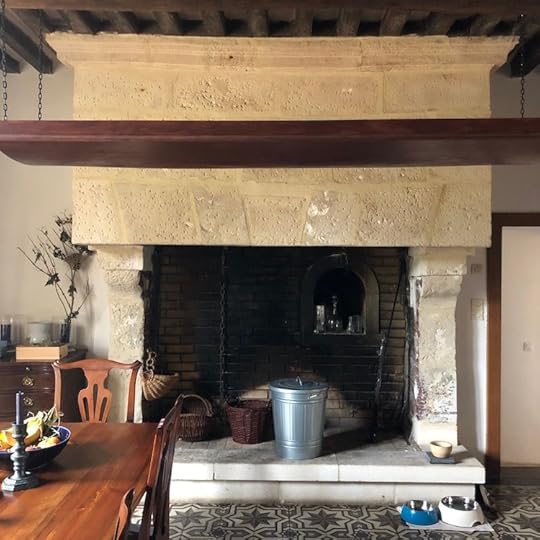
Eric also resolved the lingering mystery of whither this arch in the living room...
 Mystery arch
Mystery archWe had heard that it once led to a tower...and we had heard that no tower ever existed. From stones protruding on the outside wall, Eric concluded that it was simply and unceremoniously the door to a suspended latrine.
The upstairs, now bedrooms and my office, was originally a pigeonnier, or dovecote. Eric knew this because of the small windows at either end of the house, one of them with a landing pad...
 Pigeon hole, where once the sweet birds sang
Pigeon hole, where once the sweet birds sang...and the inside traces of which sit right above my head as I write...
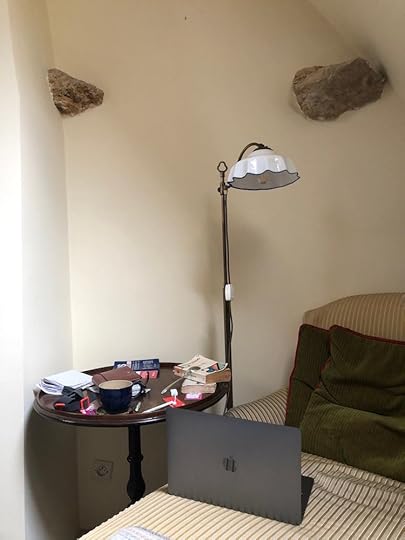
It's evening now and everyone's gone but us and the swallows, who are swooping madly about - though not in and out of the quarters David so carefully set up for them during our confinement in April.
 Barn owl hayloft, swallow shack
Barn owl hayloft, swallow shackIn fact it was short-sighted of us to think we could successfully relocate the swallows. Once the masons got to work knocking holes in what had been their summer home, the birds abandoned their shack and returned to the intact nests of their avian château. They put up with the noise and dust, staying away while work is in progress but returning as soon as the masons are having lunch or have gone home for the day. These birds need to be tenacious. Valentin the ornithologist told us that only 25% of the young survive their first migration, which will start in just a few weeks.
With the workers about to leave on holiday, the swallows will spend their last days with us in peace. It's fair to say that despite being grateful for all the recent activity, we too are looking forward to a quiet August.
Happy, healthy summer, to one and all. Rendez-vous en septembre.
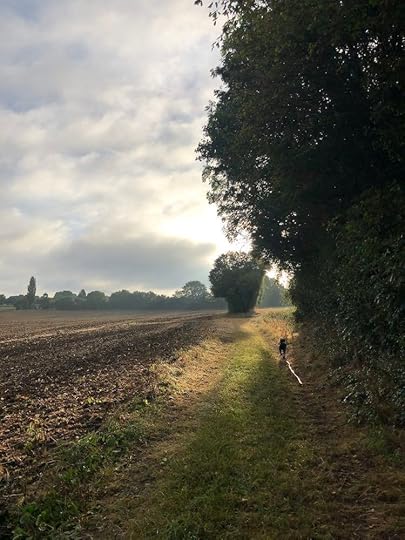
July 18, 2020
Awry July

Friday, 17 July
Every July my husband David and I have the same exchange.
He says: “Summer is now here. Paris will calm down and empty out.”
And I reply: “No it won’t. Not until August. July is one big traffic jam.”
Unfortunately I am always right. The boulevard Saint-Germain below our living room window remains a stubborn clog of cars until the minority juilletistes return from holiday and the majority aoûtistes have reconvened on the beaches.
Except this year, when we did not even have the debate. Paris may be déconfiné, with shops re-opened and restaurants feeling entitled to spill their tables as far as they like across the sidewalks and into the street, but the usual nervy buzz of the city has toned down to a drone, sometimes even near silence.
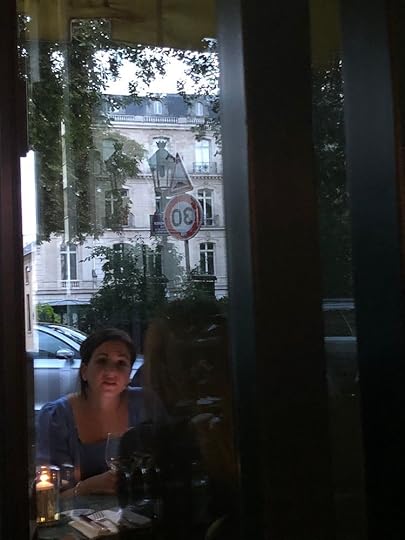
The main difference, I thought, was the absence of tourists, who in normal times occupy the city in summer like locusts. Though the borders have been opened to some countries since July 1st (the US, with its skyrocketing numbers of Covid-19 cases, is not among of the chosen), visitors have returned in a trickle to eerily closed hotels.
 Hôtel Le Meurice
Hôtel Le MeuriceIt is amazing how spacious...

...and relaxing...

...the Tuileries Gardens can be when not bursting at the seams with human beings.
I have frequently had the odd feeling of being thrown back to my first years in Paris in the early 1980s. With its increased breathing space the city seems to have regained a certain balance and dignity. As long as I don't think about all the lost jobs in the tourist industry, I am rejoicing in the retro moment.
Of course signs abound that this is not the 1980s.

In those days both urban cyclists and joggers were rare birds, more objects of mockery. Electric scooters would have been the realm of science fiction and the idea of the automobile being demoted in the transport hierarchy unimaginable.
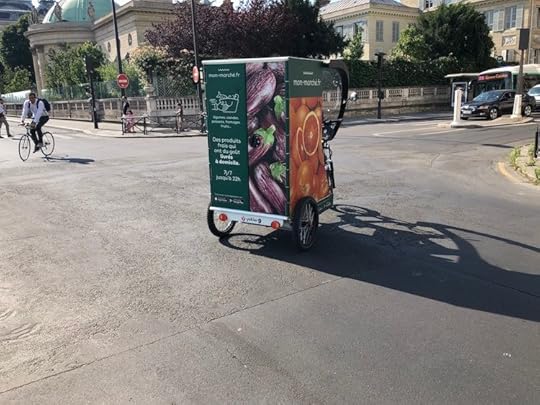
As would have been the sight of Parisiens blighting their look with unseemly face masks, a phenomenon that will become mandatory in all enclosed spaces starting next week.
Sadly nature is revealing further changes. The horse chestnuts and linden trees are being suffocated, one by a bacteria, the other by parasites, making their leaves turn brown and dry long before autumn.
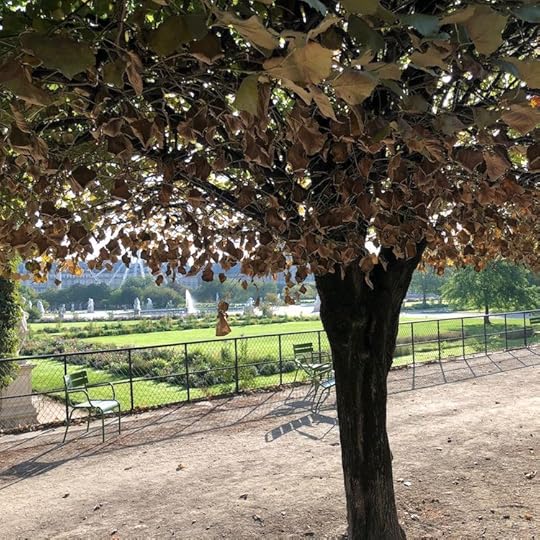
Others are succumbing to too much heat and too little rain.

It strikes me that there's more to Paris' odd mood this July than the paucity of tourists. They don't drive so cannot be responsible for what is usually an August landscape...
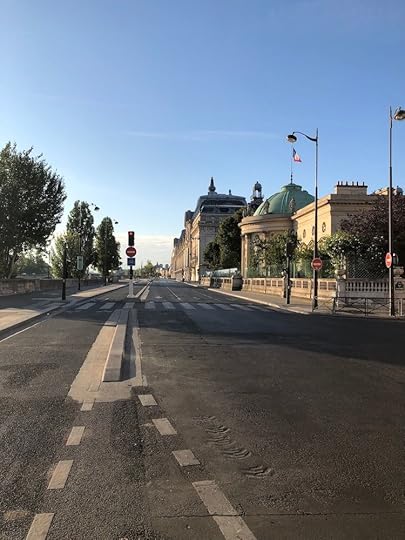
Restaurant patrons on the outside belie the scene indoors.
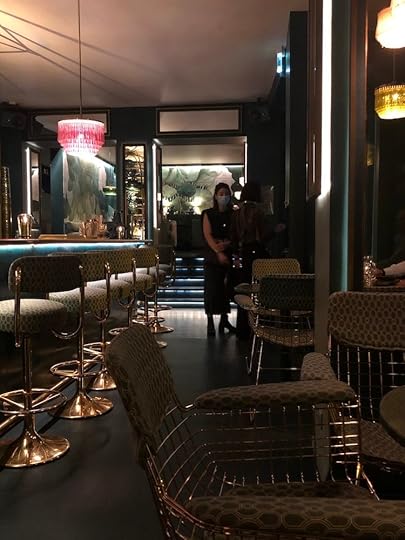
Clearly Parisiens have also stayed away, either having been made redundant or continuing to work from home or–like David and me most of the time–opting for the countryside.
Underlying the unusual July hush is angst, a feeling of suspense or suspended animation, I’m not sure which.
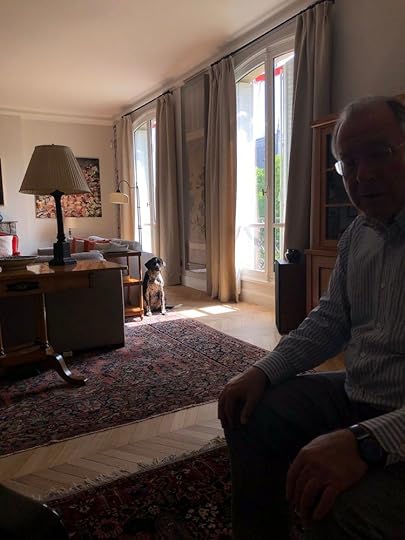
Because everyone–government officials, businesses, schools and the rest of us, perhaps only on a subliminal level–is more than usually apprehensive of la rentrée in September. Along with fear of a second wave of the pandemic is dread of the day that the effects of all the lost jobs and reduced economic activity really hit home. What this July feels like is the calm before a very big storm.
July 4, 2020
Finding the Thread

Friday, 3 July
This morning I woke up at 5 to mild panic: I am supposed to write a blog today and I do not have a single idea. After a few minutes tossing and still not even a hint of a plan, I got up, made my coffee, and did what I always do when feeling uninspired. I looked at my photos from the last two weeks. They often help me find the thread around which to weave a story.
Not so this morning. There were a couple I'd posted on Instagram (if you like my photos you can follow me here) that I thought evocative...
 Old windmill
Old windmill Tasha's World (after Andrew Wyeth)
Tasha's World (after Andrew Wyeth)...but I’ve recently written about Tasha’s World and one tower doesn’t make a tale.
Mostly the photos made my last fortnight look like a litany of discrete events that had, en plus, left little time for reflection. As real life kicks in following our two month Covid-19 confinement, so too does a scattered mind. The few days in Paris were gobbled up by chores such as getting David's bike fixed and my fortunately still under guarantee computer replaced. Back here on Friday, we had an inspiring, fascinating meeting with an organic farmer but that’s a starting point for a future, longer story. We had our first visitors in months, my son William and his girlfriend Margaux, and that was pure joy, though how strange not to be able to embrace your own child.
 Sylvain splendour
Sylvain splendourResigned to blog failure, I turned to novel revision and got a good hour and a half’s work on that done before it was time for Tasha and me to take our morning constitutional. The blog would just have to wait, however inconveniently, until the 14 juillet/Bastille Day long weekend.
For quite some time we’ve been walking between fields of tall grain—wheat, barley, rapeseed—with limited visibility. Even the corn, a late bloomer, is now growing like a class of teenagers and blocking the vista. It’s a bit like walking in a tunnel and though tunnel vision has its attractions—a good hunting prophylactic for dogs and a feeling of security for humans—it does contribute to the sense of nothing-to-report.
But this morning we walked to the top of the rise and there was this:
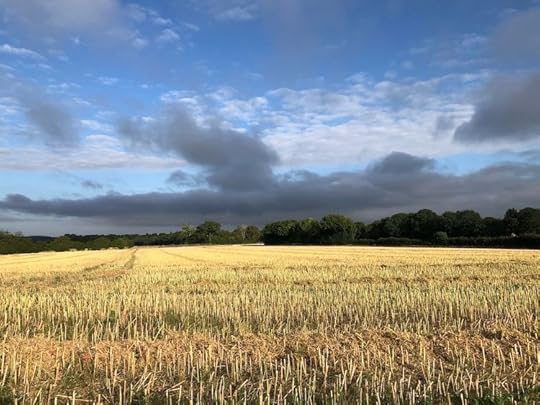
The rapeseed had been harvested and the landscape had burst open. Everything seemed different, at once scarily exposed and exhilaratingly expansive. The air smelled of straw. I knew immediately what I needed to write about: the fact that the natural world is never still. That there is, if you're been paying attention, always a story.
Now that I thought about it, there had of course been signs. The rapeseed pods had become desiccated and the stalks brittle; they rattled in the wind. The wheat has gone tawny; it rustles like a grass skirt. The wild flowers that William and Margaux had picked were not the same species as those blanketing the edges of the lane, the floor of the forest in early June. The hay in our field had been mowed and baled earlier in the week.
 Happy couple
Happy coupleYesterday I'd even heard the combine harvester, like a background instrument in the masonic symphony of hammers, drills and stone saws next door, where our barn is being renovated.
But I hadn’t considered the effect that its noise would have on the landscape. It was as if the season had changed overnight.
 New look for my friend the tree
New look for my friend the treeEven the animals seem to be aware of this evolution and are emerging from their baby-making spring hiding places. Two days ago Tasha, almost home, caught sight of a hare at the edge of a wheat field and disappeared for almost four hours (so much for my recently touting the taming of Tasha). Yesterday I spotted, thankfully before she did, two deer grazing, then watched in wonder as their silhouettes leapt in and out of the high wheat against the rising sun.
And this morning, needless to say, I wasn't the only one excited by new horizons.

It's so easy to let your mind and senses shut down, especially now that we are déconfinés and have busy, distracting days. Thank you, natural world, for giving me a good jolt, for reminding me that there's always a story to tell.
June 20, 2020
Renovating Mind and Matter

Friday, 19 June
Our third major renovation project in six years is now underway. After Berlin 2014-15 and Paris 2017-18, it’s the Perche 2020-21. Or so we hope. If there’s one thing we’ve learned from experience, it’s pay no attention to predicted time frames. Neither of the first two projects, for example, was supposed to be hyphenated.
Given the frenetic rhythm of the last six years, you’d think that David and I actually liked recreating our home life on a regular basis. In fact we don’t like it at all but it's part of the fall-out from our moving half-time to Germany, then moving back full-time to France. If we've learned a second thing from experience, it's never underestimate the disruptions and reverberations that displacement causes.
Each renovation has had its own logic. In Berlin we were irresistibly drawn to the potential of the place, even before there was a living room floor…

…and in Paris, after 20 years, five children and three dogs, the flat needed much freshening and a more adult-friendly distribution of space.
When we saw this house in the Perche—the first in our search—David said: “It’s nice. But we'd have to do up the barn. And we’re not doing any more renovation work.”
“You’re absolutely right,” I answered. “After Paris and Berlin, no more work.”
Several months of house-hunting later and yet another lesson learnt—that the house-needing-no-work does not exist—back we fortunately went to square one, this 16th century seignurie.
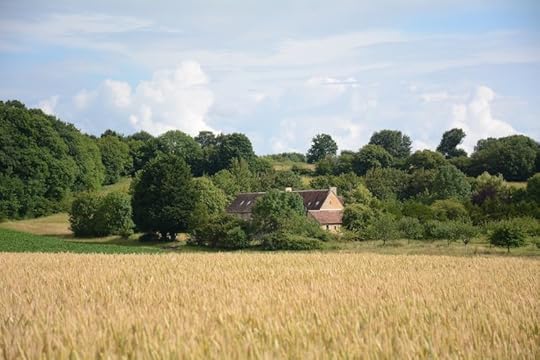
And ‘doing up the barn’, ie turning the ground floor into a sitting room and master bedroom, is only Step One of the actual project. In Step Two we break through the wall between the erstwhile barn and the house, then overhaul the latter, which received its most recent makeover sometime well into the last century.
I have been dreading this undertaking and not just because it’s the third complete upheaval to our lives in a very short time. A big part of me simply did not want to destroy the barn, home to a large family of swallows and testimony to the property’s original raison d’être, a farm. I do not like wrecking our link to the past.
Decamping our upstairs bedroom and David's office to the main house, we eased into the works with repairing a section of the roof. The old tiles were removed, the roofers tossing them to one another in stacks of three or four as gracefully as rugby players. The ball was never dropped.

Already damaged ones were put in one pile; those that could be re-used stacked up in another.
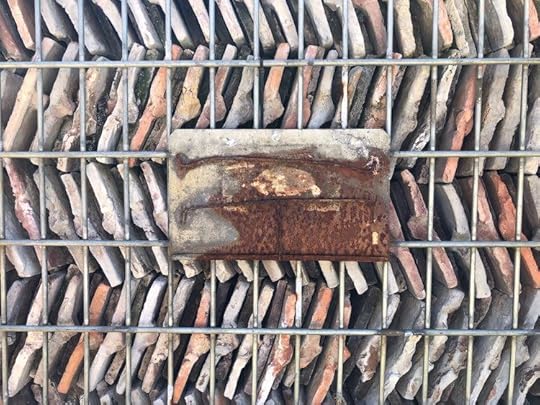
New insulation was inserted, a new wooden framework to hold the tiles in place was hammered on and finally the new and old tiles were re-laid. It was a wonder to behold.
 Getting ready for service
Getting ready for service Finishing touches
Finishing touchesThree weeks ago the masons arrived, just as the roofers were finishing, and their first task is to bash holes in the barn walls and enlarge windows, build new doors. We missed the first acts of demolition because I was in Paris undergoing the dental equivalent, the extraction of a large molar. Events in our lives can oddly mirror one another.

By the time we returned the masons had made good progress. If it looks as though their work is more destructive, less artful than the roofers, it is a false impression. After they smash a hole, they rebuild the window or door frame by hewing and inserting new stone in the Perche style...
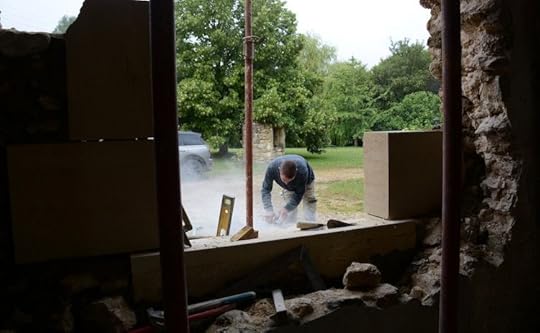
…then surrounding it with the old stones from the rubble of what has been knocked out. Stone by stone.

If one doesn’t fit, they choose another, use a level to make sure it works in the bigger picture before slapping on the plaster to hold the the whole thing together. Another wonder to behold.

During our two-month cornonvirus confinement, I had a lot of time to say good-bye to the barn. On the way to and from our bedroom or David’s office upstairs, I’d stop, take some photos.

I even made a little video. One day I climbed a ladder and cut away a swallow’s nest, a memento for posterity.
 Swallow's nest and discarded roof tiles
Swallow's nest and discarded roof tilesAll the while I reasoned with myself, fought a weakness for nostalgia. A barn without animals—this year even without swallows—is a sad place.
 Droopy milking machinery
Droopy milking machineryBeing chained to the status quo is unhealthy. Transformation does not necessarily mean ruination, I told myself.
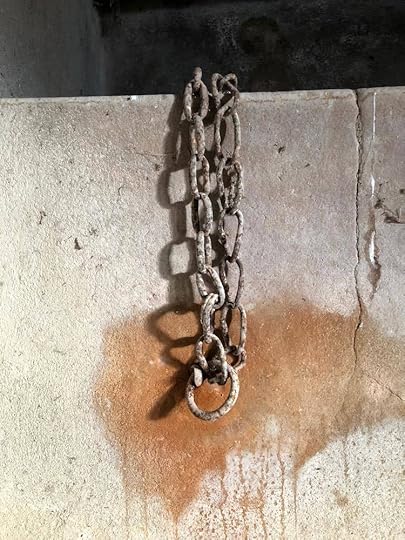
The works have proven this internal discourse. There is something exhilarating about all these holes, about the light streaming into what was a dark, unused space. It seems right to be giving the building a new purpose, a different way to connect with the land around it.
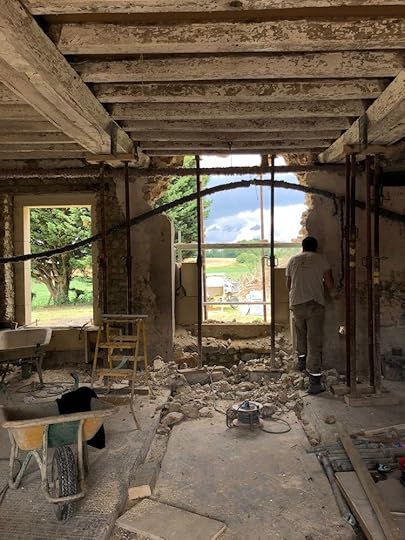
And to connect with the past. The roofers and masons, re-using tiles and stones with artisanal methods that are centuries old, form a direct link to the Perche and the house's heritage and that what I must focus on.
Consider this project, then, a renovation of mind and matter. However long it lasts.
May 30, 2020
The Taming of Tasha?
 The Wild One amid the wild flowers
The Wild One amid the wild flowersFriday, 29 May
On our walk through the Perche countryside this morning, it occurred to me that Tasha the dog has some striking similarities to Voltaire’s Candide. For those of you who have not read the eponymous novel by the Enlightenment philosopher: it is the picaresque tale of bastard Candide, forced out of the baron's domain and into a world of suffering and horror. After many travels and travails, he learns the importance of seeking fulfilment in his own backyard and settles down to life on a farm. “Il faut cultiver notre jardin,” he says.

Tasha, a rescue dog of unknown origins who looks and acts like a princess, obviously underwent some ordeals in her first two years of life; she was scared of everything and everyone. Like Candide, she too landed in El Dorado (aka the Fleming-Morrison Paris household), then had more adventures in Berlin and still more in her first year here in the Perche, where she departed on far-ranging hunting excursions of protracted duration.

But her quest for new thrills got out of hand and two months ago travel restrictions were imposed. Under the new regime walks are to be taken with, not away from, her human companions. To ensure she sticks to the path she wears a long orange lead.

There has been some deviation from the rules - a few mad chases after hares, another after a fox - but these animals quickly retreat into their holes and she loses interest, returns to the straight and narrow. Fortunately her preferred prey deer, who just keep running, have been scarce recently. Perhaps they are sticking to the woods to care for their young or are deterred from venturing into the fields because the wheat, barley and rapeseed are high now and so tightly planted even the voles (those that have survived the pesticides) must be elbowing their way around.
With new paradigms come new responsibilities. Tasha has, for example, become my personal trainer. Trying to keep up with her and the long orange lead - instead of stopping frequently when she's run out of sight and calling frantically - means my brisk pace never slackens. Ditto when we go running together. If I do spot an animal of possible interest before she does and grab the line, holding her back provides a great upper body workout too.
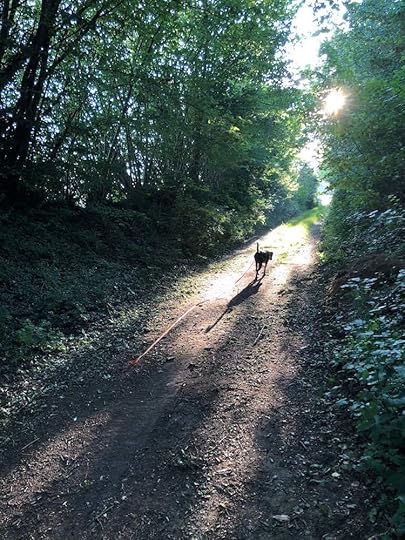
Tasha has also become an avid lizard hunter though thankfully not a very good one. She pursues them tirelessly amidst the flower beds and up and down the walls but they are generally too small and quick for her. Only one tail has been spotted disappearing down her gullet. Despite a low success rate on she cheerily hunts.

If the lizards have made Tasha lose interest in the larger prey beyond the confines of our garden, it must be said that she had mixed feelings about the hunting expeditions in the first place. Every time, she'd come home from her forays contritely whimpering, like a drug addict returning from a binge. Not to get Panglossian about it, I have every reason to hope that our detox strategy is working and that she is actually happier, more relaxed, in this newly domesticated life.
There’s a lot of talk at the moment about the effects of Covid-19 and two-month’s confinement on us human beings. Will we have learned in any long-term way to appreciate a slower pace and a more inward-focused existence? Or will we quickly revert to our overactive-travelling, excitement-seeking, planet-killing selves?
Voltaire wrote his satire Candide in the wake of the Seven Years War and the earthquake, tsunami and fires that ravaged Lisbon in 1755. These disasters, with catastrophic human cost, flew in the face of a leading philosophical principle of the time, Optimism, which purports that God ensures everything occurs for the best in the best of all possible worlds. Candide, after witnessing many horrors (including the war and the cataclysm in Lisbon), learns the delusions of Optimism and the merits of focusing his energy on his own small orbit, of cultivating his garden. A bit like Tasha.
It would be great if our post-coronavirus world followed suit but I'm not optimistic.
 Got to get back to the garden
Got to get back to the garden
May 16, 2020
From Confinement to Confusion

Friday, 15 May
When it comes to French history, I should know better than to rely on the internet. I should know to go straight to my friend Diane A-C.
Last entry I sketched the history of the May 1st labour holiday in France but my précis lacked nuance. Here, with my apologies for over-simplification and thanks to Diane for setting the record straight, is the fuller, accurate story that she sent to me:
“A small correction on the history of May 1st, a pirouette performance at which France excels: it was the Vichy regime in 1941 that officially made the first of May Labour Day (la fête du travail), in complete agreement with the Communist Party, which collaborated zealously until the German-Soviet pact was broken…it was Vichy that imposed the return of the lily-of-the-valley, which at the time of the Revolution was replaced by the red eglantine (wild rose, in honour of Fabre d’Eglantine, to whom we owe the words of the Marseillaise with “the impure blood that waters our furrows…”). Anger, always anger behind the wispy white flower’s little bell.”
History is messy and often so is the present. As we begin our déconfinement from the coronavirus lockdown this week here in France it feels if not chaotic then confused. Choleric the French are and there is much disagreement and strife about everything from which schools should open when to what guidelines will apply to the sacred ssummer holidays.
 From Le Parisien,the prime minister Edouard Philippe, emphasis on 'relatif'
From Le Parisien,the prime minister Edouard Philippe, emphasis on 'relatif'The authorities nevertheless always have a plan. In good Cartesian fashion, the country has been divided into three zones: red, yellow and green. The Perche, where we have been holed up for the duration of the confinement, is green, meaning that as of May 11 we could crawl out of our burrow and return to some semblance of normality. On the other hand Paris, where we spend much of our real lives, is red, meaning the city should remain locked down.
Because I am in sore need of a trip to the dentist and we thought it not a bad idea to check that a pipe hadn’t burst or a wire short-circuited during our two-month absence, we returned to the capital for a three-day visit on Wednesday. But was the trip, from green to red zone (and back!), authorised?
 Paris bus stop poster: 'Stay home!'
Paris bus stop poster: 'Stay home!'Here's what we understood about the new rules:
- you no longer need to carry a form with date, time and destination, every time you walk out the door.
- you can go out for longer than one-hour and farther than the previous 1 km perimeter. In fact, with a justificatif de domicile (proof of residence) you can stay out as long as you like within a 100 km radius of your home.
This is true across the country. So what, exactly, is the difference between red and green zones?
Still, off we drove—Tasha, having not set paw in the car for two months, did her best to control her panic—armed with two electricity bills, one for the Perche, one for Paris. Since our residences are 181km apart, we would claim being within 90.5km of one or the other. But we were not stopped, did not even see a police car.
It is heavenly to be back in our intact flat, which still feels very much like Home. Being able to reach our bedroom without walking outside and through the swallow poo in the barn seems a luxury. Even Tasha scampered here and there with yelps of relieved recognition.
But venturing beyond the front door was another matter. Having grown used to a low microbe environment, even the bourgeois 7ème arrondissement feels rather high-risk. I think Tasha spoke for the three of us when she barked out the window.
 Concerned canine
Concerned canineAs is so often the case in France, what’s written on paper doesn’t match what happens on the ground. Red zone or not, the traffic is beginning to pick up and shops are opening all over. On two occasions - once at the Canal St Martin and once at the Sacré Coeur - tightly-packed groups of young people partying were disbanded by the police. In our quartier, a moribund pall persists, as if a vital fluid had stopped flowing through the city's veins. Masked pedestrians circulate like bubbles in a glass of cold water.
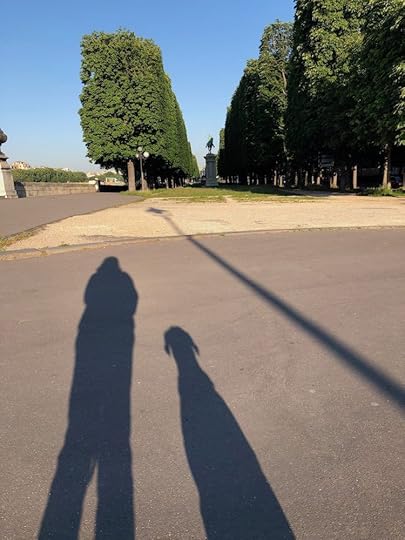
The morning walk with Tasha, however, has given me a different perspective. Because the Tuileries are closed, we walk along the almost empty quaysides, where humans are scant and nature is flourishing. Tasha frolics with aplomb in grass not much shorter than it is in the country.
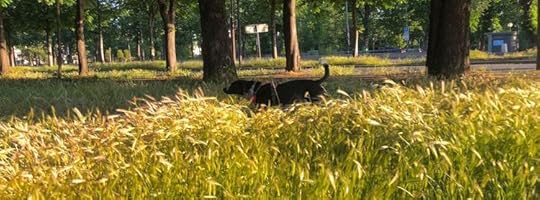
Streetlights have taken on a life of their own.

Next to the pont de Solférino, I photographed a fisherman photographing the catfish he had caught before he threw it back in the Seine. Who knew such giant creatures were living in our midst?

I have some sympathy for the government’s colour blind confusion about our déconfinement. No one knows what path this little understood virus will take, especially when given more freedom. On the other hand humans can't be kept locked down forever. Paris may feel comatose and scary but the air is cleaner and nature is thriving. It would be sad to see these improvements rolled back and maybe they won't, since in the longer term, how attractive will a dense, polluted and infectious urban hub be? I'm certainly scurrying happily back to the country tomorrow.
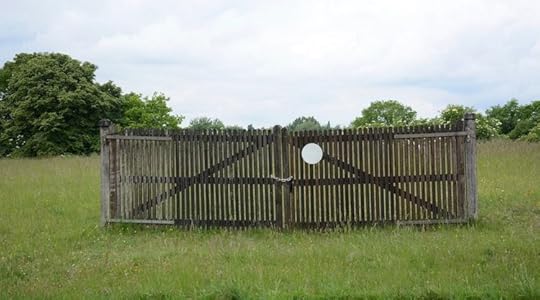
We are stumbling into very uncertain territory, meaning messy times in the future, as well as in the past and present.
May 2, 2020
Confinement, Part IV

Friday, 1st May
It’s May Day, a day to celebrate spring and labour. With nature and work much on my mind this 46th day of our confinement, it’s a timely holiday.
 Happy spring from my flower bed
Happy spring from my flower bedThe earliest known observation of the day goes back to the 2nd century, with festive vernal events around the Roman gods Flora, Dionysus and Venus. Later the Christians got a hold of it and feted various saints and the Virgin Mary, along with the arrival of spring. In the late 19th century the day was appropriated by trade unions to honour workers, following the 1886 Haymarket affair in my hometown of Chicago. Labour had begun a general strike on May 1st, demanding an eight-hour working day. During a demonstration a bomb went off and many labour leaders were subsequently rounded up and hanged on dubious charges.

Three years later, at the first congress of the Second International in Paris, the May Day holiday was designated. It’s not surprising that the French were behind the effort. With workers' rights considered hallowed territory here, le 1er mai is sacred, the one day in the year where absolutely all shops and businesses are closed. In healthier times there are packed parades to celebrate the working population. Since 1988 the extreme-right National Front (now the Rassemblement National) have held their own parades on le 1er mai, paying tribute to Joan of Arc while promoting their xenophobic agenda.
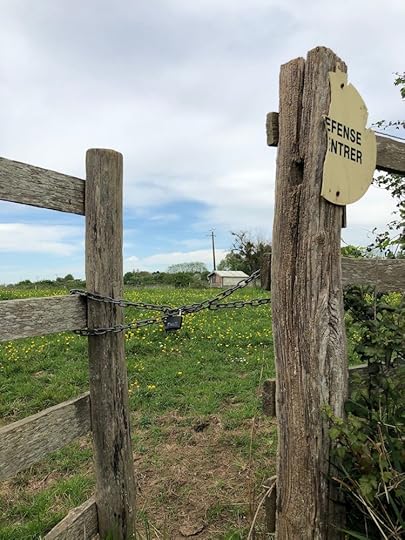
Fortunately some traditions that surround the day in France are less political. In 1561 King Charles IX was given lily-of-the-valley for good luck and decided that the ladies of the court should also receive these talismans. Since then muguets are sold in industrial quantities just before the holiday. In the last few days re-opened flower shops have joined the ranks of commercial enterprises deemed de caractère indispensable by the government during lockdown.
 Indispensable goods
Indispensable goodsGiven the explosion of spring and the lack of other distractions in these confining times, I have been very focused on the season out here in the Perche. The lilacs, hawthorns, elderberry and cherry...
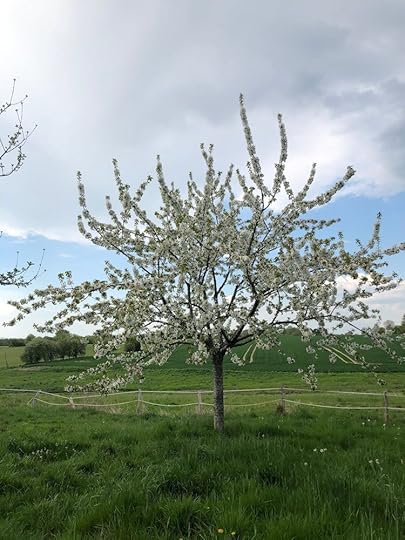
...that have been blooming all around. But I have also been thinking about us humans and our relationship to nature.
People, though still officially confined, have started poking their heads out of their holes in the last two weeks. It's more crowded when I shop in the town. The grass paths I walk along with Tasha in the morning have been mown by the village authorities.
And we've had two visits (distanciation sociale dutifully respected). Monsieur L, the farmer who sold us the land around the house and who continues cultivate it, stopped by to tell us that he was set to start planting maize. Watching the tractors turn over the soil is a powerfully dramatic process...

...that is strangely beautiful...

The word cultivation rings just right.
The second visit was from Claire S, landscape architect and eco-expert who will be helping us redesign our property, make the garden flow harmoniously into the land that Monsieur L will stop farming over the next few years as he eases into retirement. Our region is still a bucolic paradise but it has not been spared industrialisation and misguided EU agricultural policies. Many of the hedgerows for which the area is known and that are home to birds, animals and insects, have been cut down or abandoned. Crops unsuited to the land - maize for example - are planted and treated with pesticides.
Claire has already done quite a lot of research into the geography and history of the place. Her broad aim is to return our 20 hectares (50 acres) into an area that is more respectful of Perche traditions and its flora and fauna and we are very excited about this project to help our environment.
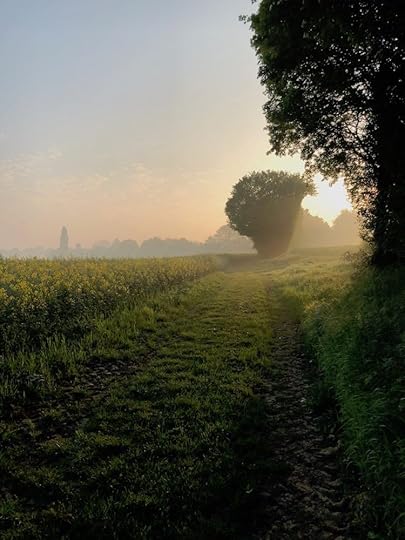
This spring has also been a fruitful time for work. Not only are my confinement blog entries beginning to resemble a serialised 19th century novel, I have been overhauling my own work of fiction, the one I was unable to finish when we were constantly hopping back and forth from Paris to Berlin. Yesterday I gave my husband David, always my first reader, the first 50 revised pages and I await his reaction anxiously. I hope very much this focused time has got me headed in the right direction.
Our de-confinement will begin shortly, on the 11th of May, and I admit to feelings of trepidation as the end to my cocooned existence approaches. On the one hand, the return to every day problems and a masked, gloved world reeling from economic collapse is an extremely scary prospect. On the other I worry about how long the salutary effects of our slower, more reflective, less polluted living will last. We are after all an insatiable species with a short memory.
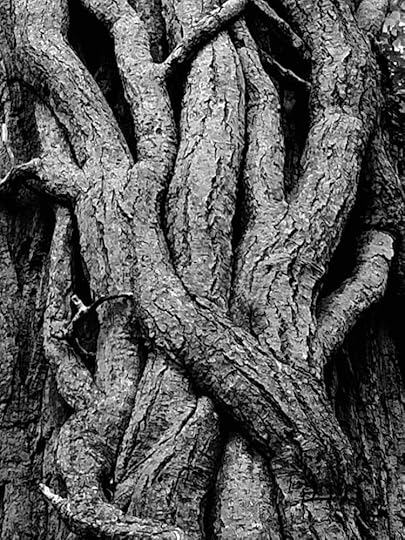
But hey, it's May Day. Happy spring. And thanks to all the workers who have helped make these confined times so fertile.



